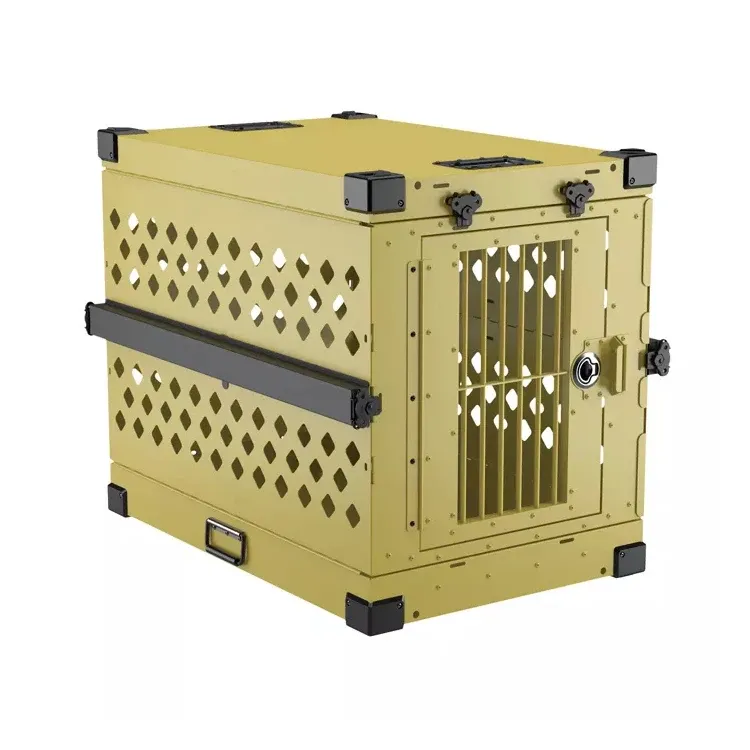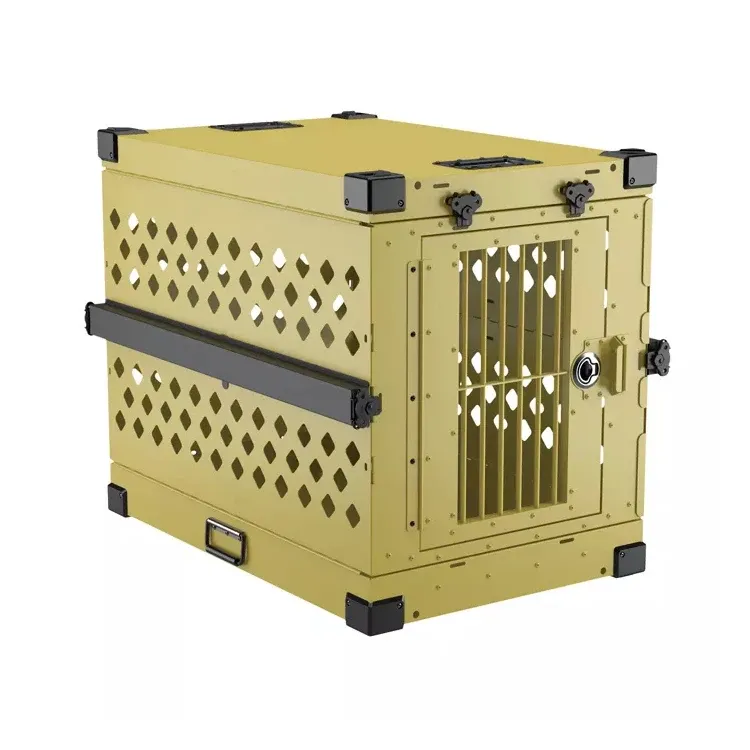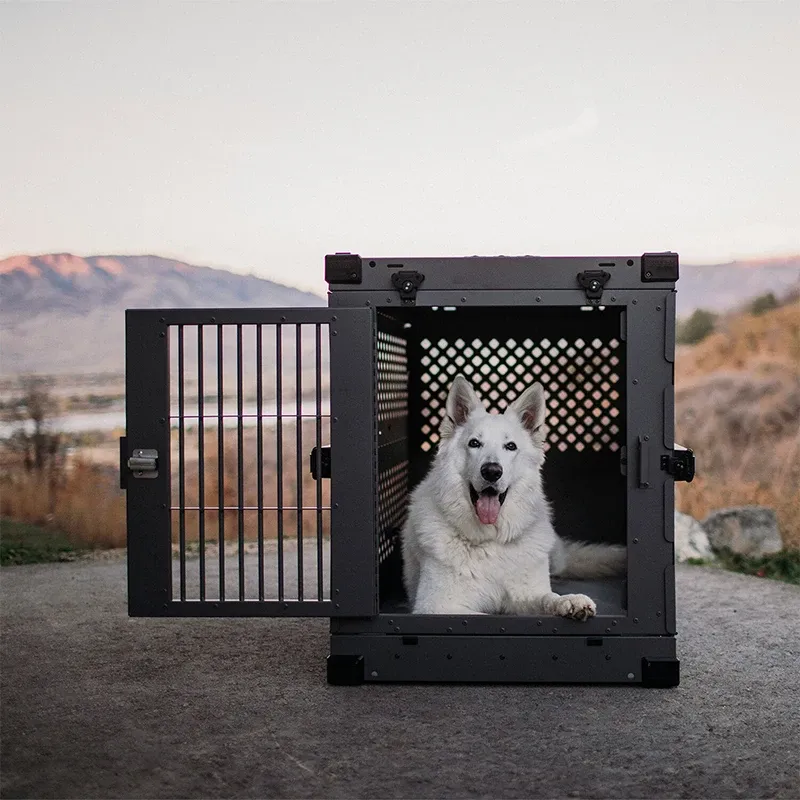





Aluminum Collapsible Dog Crate For Large Dog Rottweiler Kennel Carrier Cage
0
sales
Regular Price
$0.00
Regular Price
Sale Price
$680.00
Congrats! You are eligible for FREE Shipping
United States
Size
24inch*18inch*22inch
30inch*20inch*22inch
34inch*23inch*28inch
40inch*23inch*29inch
48inch*26inch*33inch
When it comes to determining the ideal crate time for your furry friend, it's not a one-size-fits-all situation. There are several factors that come into play, and understanding them is key to providing the best crate experience possible. Let's dig into these factors, starting with the age and health of your dog. Age and health of the dog Do you think puppies and older dogs have different dog crate needs? The answer, my friend, is a resounding yes! While puppies are bundles of energy, they have bladders the size of a thimble and need frequent potty breaks. So, keeping them confined for too long can lead to accidents, and trust me, nobody wants that. On the other hand, older dogs may have different considerations. They might have arthritis, joint issues, or other health conditions that affect their comfort levels. Crate time for these seasoned pups needs to be adjusted accordingly to ensure they're not feeling any unnecessary discomfort.
Size and breed of the dog
From tiny Chihuahuas to majestic Great Danes, their size can make a difference in their crate needs. A small dog may feel overwhelmed in a crate that's too spacious, while a larger dog might find a cramped crate to be more akin to a claustrophobic nightmare. Size is not the only concern here though. Consider the breed of your dog. Is it a bouncy Border Collie or a laid-back Bulldog? Different breeds have different activity levels, which can impact their crate time requirements. Active breeds might need more frequent breaks and exercise to avoid getting antsy, while sedentary breeds may be content with longer periods of crate time.
Previous crate training experience
Has your dog been previously acquainted with the crate lifestyle? If they've already mastered the art of crate confinement, they might be more comfortable spending longer periods in their crate. On the other hand, if your dog is a crate newbie, you'll need to introduce them to this cozy den gradually.
Remember, patience and positive reinforcement are key to crate training success!
Duration and purpose of crate confinement
Sometimes, we need to pop our furry pals into their crates for short-term confinement. Think about those road trips or flights when we need to transport them safely. During these moments, it's important to keep their time in the crate to a minimum. We don't want them feeling like they're trapped in a never-ending journey, do we?On the flip side, there are situations when dogs might need to spend longer hours in their crates. For instance, during work hours when you're away from home, creating a safe and comfortable crate environment can help prevent accidents or destructive behavior. But remember, even in these situations, regular breaks and exercise are crucial for their well-being.
Recommended Crate Time Guidelines
Now that we've considered the various factors that influence crate time, let's get down to brass tacks and discuss some general guidelines to keep in mind. Remember, these are just rough estimates, and every dog is unique. Tailor these guidelines to suit your dog's specific needs and adjust as necessary.
Crate time for puppies
They steal our hearts with their playful antics and puppy breath, but when it comes to crate time, we need to be mindful of their tiny bladders and boundless energy.
Take note of the following recommended crate time guidelines for our adorable little furballs:
Young puppies (8-10 weeks): The tiniest fluff balls of them all. For these little ones, crate time should be limited to around 30-60 minutes at a time. They simply can't hold their bladder for much longer without making a mess!
Older puppies (3-6 months): As puppies grow older, their bladder capacity improves. You can gradually extend their crate time to 1-3 hours. Just keep an eye on them and provide potty breaks to avoid any unexpected puddles.
Adolescent puppies (6-12 months): The teenage phase! These pups are bursting with energy, so crate time can be extended to around 3-6 hours. But remember, they still need regular exercise and mental stimulation to prevent them from feeling like they're bouncing off the walls.
Crate time for adult dogs
Now, let's move on to our adult dogs, the seasoned companions who have already passed through their puppyhood.
Here are some recommended crate time guidelines for our fully grown buddies:
Healthy adult dogs: For our adult canines in good health, aim for crate time around 4-6 hours, and certainly not more than 8 hours. They have better bladder control and can handle more extended periods of confinement.
Senior dogs: Our golden oldies who deserve all the love and care in the world. For our senior companions, it's best to limit their crate time to around 2-4 hours. Age can bring about a decrease in bladder control and potential discomfort, so shorter crate sessions are recommended.
Breed consideration for crate times
Active breeds: Picture those dogs who are always ready for a game of fetch or a jog in the park. Active breeds, like Border Collies or Australian Shepherds, have an abundance of energy that needs to be released. As a result, they may require shorter crate time intervals to prevent them from going stir-crazy.
Sedentary breeds: On the flip side, we have our couch potato companions who prefer a laid-back lifestyle. Think of Bulldogs or Basset Hounds, who would rather snooze the day away than embark on vigorous adventures. Sedentary breeds may tolerate longer crate time, as they're generally content with taking it easy.
Strategies for Safe and Comfortable Crate Time
Now that we have a good understanding of the recommended crate time guidelines, let's dive into some strategies to make crate time a safe and cozy experience for our furry pals. By implementing them, you can ensure that your dog feels comfortable, content, and even a little excited about their crate.
Preparing the crate environment
First things first, let's set the stage for crate time success. Start by choosing an appropriate crate size. It should be spacious enough for your dog to stand up, turn around, and lie down comfortably. A crate that's too small can make your dog feel cramped, while one that's too big may not provide the cozy den-like feeling they crave. Next, add some comfortable bedding and toys to make the crate inviting. A soft blanket or cushion will provide a cozy spot for your dog to relax. Toss in a few toys or chew treats to keep them entertained during their crate stay. Next, you should ensure proper ventilation and temperature in the crate area. Good airflow is essential to prevent overheating, so make sure there are openings or crate designs that allow for adequate air circulation. Be mindful of the temperature around the crate. You should avoid placing it in direct sunlight or drafty areas, as extreme temperatures can make your dog uncomfortable.
Regular exercise and mental stimulation
A tired dog is a happy dog, and this holds true for crate time as well. Before putting your dog in the crate, make sure they've had a sufficient amount of exercise. A nice walk, a game of fetch, or some training sessions can help burn off excess energy and make them more likely to settle down in the crate. Additionally, provide interactive toys and puzzles to keep their minds engaged during crate time. Puzzle feeders or treat-dispensing toys can provide mental stimulation and keep your dog entertained. It's like having their very own "crate-cation" where they can focus on a fun challenge.
Gradual crate training
Introducing the crate as a positive space is super important for crate training success. You need to make the crate a happy place by associating it with positive experiences. Start by placing treats or their favorite toy near the crate, and gradually, encourage your dog to explore the crate by placing treats or toys inside and praising them for going in. Remember, patience is key during this process. Incrementally increase crate time as your dog becomes more comfortable. Begin with short intervals, such as a few minutes, and gradually extend the time. Each time your dog enters the crate willingly and remains calm, reward them with praise and treats. This gradual approach helps build their confidence and acceptance of crate time.
Bathroom and feeding breaks
Establishing a routine for potty breaks is essential to prevent accidents and discomfort. Take your dog for a potty break before placing them in the crate and provide immediate access to a designated bathroom spot once they're out. This routine helps reinforce proper bathroom habits and minimizes the chances of accidents during crate time. Timing meals and water intake can also play a role in preventing accidents. Offer meals and water a reasonable time before crate time to allow for digestion and elimination. This way, your dog will have a chance to relieve themselves before going into the crate.


